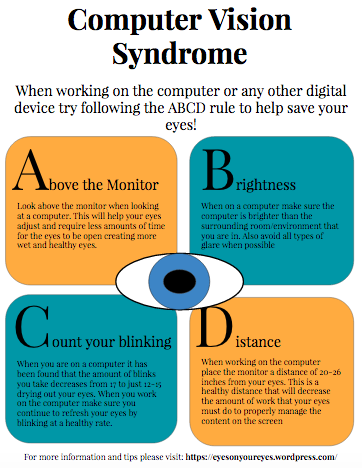Computer Vision Syndrome
If a college student is in the library, odds are they are going to use a computer or a laptop at some point if not the majority of their visit. Very often these devices are sources of textbooks, supplemental material and also different “study break distractions.” We also use computers to write papers, closely analyze large amounts of data and also to communicate with others. In summary- we use them very often, and when we do use them it is normally for a very long time.
You have probably heard that computers aren’t good for your eyes, and no shocker, they aren’t.
Computers are unique because they are digital and have seemingly endless possibilities of content and information available on them. Even with this, people often argue that it is easier to read off of a piece of printed-paper rather than a computer or other electronic devices. The artificial brightness of the computer, as well as the pixelated fonts create unclear images that your eyes have difficulty reading- showing that this preference to the “old stuff” has merit to it. The Journal of Medical Practice and Reviews published a study that found people who work for 3+ hours on a computer a day including professionals in the fields of banking, architecture, engineering among more, as well as students are at the highest risk of Computer Vision Syndrome.
With this, there are several tricks and suggestions that you can follow to decrease the harmful effects of computers on your eyes. Follow the ABCD model of protecting your eyes from computers and other digital screens.
- A- Above the Monitor- when at a computer, your eyes should be level with the top of the monitor, if not slightly above the monitor screen. This allows for a decrease in dryness in your eyes as they no longer are required to be completely open when looking at the screen.
- B- Brightness- always make sure your screen is brighter than wherever you are. This can include being outdoors, or in a bright room/building. To help with this, dim the lights or put down blinds or shades in the location where you are working to allow the screen to be the brightest. On a similar note, avoid any type of glare on your computer screen, as it can require more adjustment by the eyes with different levels of light being put off.
- C- Count- how many blinks you do in a minute? Odds are, when using the computer your blink count decreases from the normal healthy 17 blinks per minute to just 12-15 creating dry eye, and reducing the amount of necessary proteins the eyes can get.
- D- Distance- the distance your face is to the monitor can be one of the easiest changes that carries the largest effects. The recommended distance from your face to the monitor is 20-26 inches. The closer the monitor is to your face, the more your eye must work to adjust to properly focus on the screen and see clearly.
By following these rules, your symptoms of Computer Vision Syndrome should drastically decrease allowing for eyes to remain in better shape, and overall be much healthier. With this, even if you are following these suggestions it is suggested that you still take normal breaks from work to give your eyes the rest they require. For information on the best type of break, please look at the 20-20-20 Rule page for more information on this topic, and remember to get your eyes checked by a professional often.
